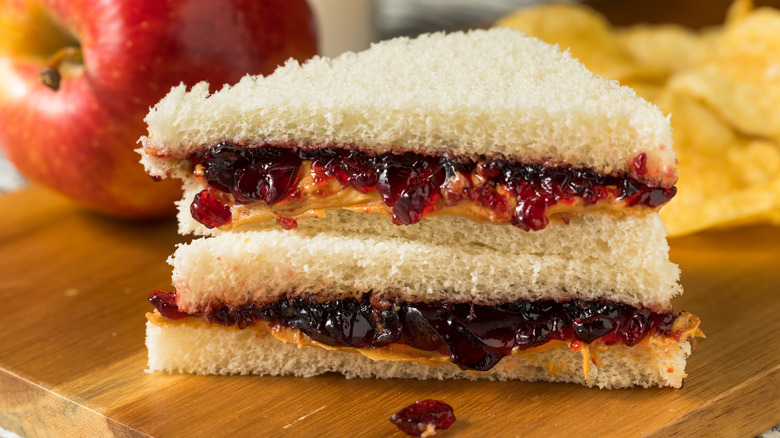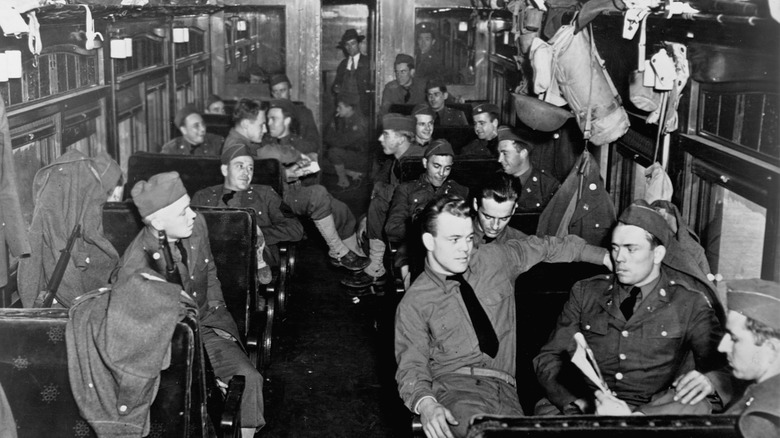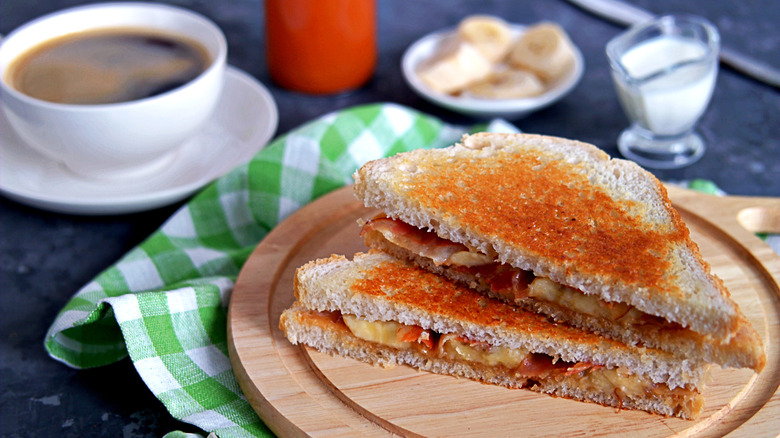The First Peanut Butter And Jelly Sandwich Featured An Unusual Flavor
That clichéd expression "As American as apple pie" could very well be replaced with "As American as a peanut butter and jelly sandwich" given how the snack is one of many under-the-radar dishes that define American cuisine.
But the first known published recipe for a peanut butter and jelly, from the Boston Cooking School Magazine of Culinary Science and Domestic Economics in 1901, looks a bit different from what, say, Ina Garten considers the jam in a PB&J today (via the Internet Archive). In the chapter "Peanuts and Pralines," Julia Davis Chandler suggested the PB&J as a kind of mini club sandwich ("bread fingers," she wrote) with likely a very tart flavor profile: "three very thin layers of bread and two of filling" — "peanut paste" and either currant or crab apple jelly — nary a grape, strawberry, and or raspberry in sight.
Any American kid who's ever bitten into a crab apple torn from a random backyard tree has instantly regretted it and then furiously spat out the ultra-sour flesh. And wild currants, beautiful as they are, also hit high on the tart scale. Yet crabapples and currants have one other thing in common: They make excellent jellies and jams. The sugar used to make jelly balances out the tartness. Then factor in the contrast between the sweet-tart gooeyness of the jelly with the salty-nuttiness of the peanut butter and you have a "delicious, and, so far as I know, original" combination, Chandler wrote.
How a war boosted the popularity of the PB&J
Julia Davis Chandler may have been the peanut butter and jelly pioneer, inspiring its rise as a scratch-made treat for elites in their tea rooms, but not until World War II did the sandwich really take off. So what happened in the decades between Chandler's recipe and the U.S. involvement in the war?
Sliced bread and shelf-stable peanut butter became widely available to consumers, and a man named Paul Welch (yes, that Welch) patented a process of turning pureed Concord grapes into a jelly, which was then marketed as "Grapelade." That meant that the three ingredients of the sandwich didn't have to be made from scratch and became easily accessible to American families during the Great Depression; PB&J sandwiches could be made quickly and easily to feed American schoolchildren and were used as a way to assimilate immigrants, too, by strongly encouraging them to eat like an 'American.'
And, finally, the clincher: The U.S. military added peanut butter and jelly to its ration menus. The sandwich proved popular with soldiers in the trenches because it was easy to make and carry while being nutrient-dense and satisfying. The combo inevitably found its way from the rucksacks of the soldiers to the backpacks of their kids after the war was over.
Some other peanut butter combos for the adventurous
It's worth noting that before Julia Davis Chandler immortalized the marriage of peanut paste and jelly in print, peanut butter (sans fruit) sandwiches were already a thing, and continued to be so, for decades. A precursor to peanut butter was developed in the 1880s as an easy-to-consume food for seniors, and later iterations became more popular in tea rooms after the 1893 and 1904 World Fairs paired the paste with ingredients like watercress or pimento.
So it's no wonder that the idea of using a spicy ingredient to elevate your peanut butter and jelly sandwich or skipping the preserves altogether and either trying full savory or dessert-sweet options is not a recent trend at all. Peanut butter and bacon is a common combo but you can add sliced bananas to it, too, which is similar to the sandwich Elvis loved so much that he ate it by the loaf. And if you're really a fan of the combination of sweet and salty, you might appreciate the sweet-saltiness of peanut butter paired with the brininess of bread-and-butter pickles, pickled red onions, or even crunchy potato chips.
And here's an idea along the same lines for adults over 21: Pair your PB&J or even PB&O(nions) with a dirty or filthy martini cocktail and report back!



